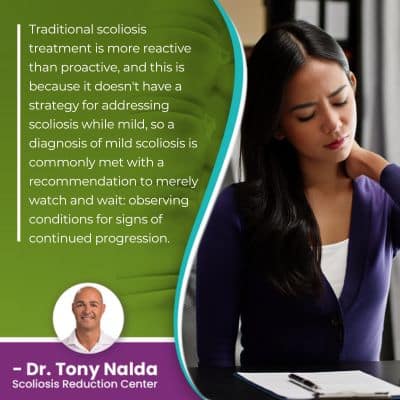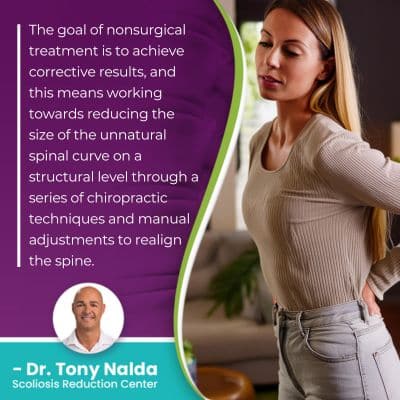How To Fix Scoliosis Naturally? [Treatment Options Explained]

The most natural way to fix scoliosis is through a proactive conservative chiropractic-centered treatment approach because it's aligned with the spine's natural movement-based design; the goal of conservative treatment is to address scoliosis proactively, while preserving as much of the spine's natural strength and function as possible, and the goal of scoliosis surgery is to stop conditions from progressing.
When it comes to fixing scoliosis naturally, we're talking about the difference between surgical and nonsurgical scoliosis treatment. Surgical scoliosis treatment involves fusing the spine and is invasive, while a conservative treatment approach offers a more natural nonsurgical treatment alternative.
When a diagnosis of scoliosis is given, the most important decision to be made is how to treat it moving forward, and there are two main types of treatment for patients to choose between.
Table of Contents
Scoliosis Treatment Options: Traditional versus Conservative
If a diagnosis of scoliosis has been given, an unnatural spinal curve that also twists has developed, and as a progressive condition, the nature of scoliosis is to get worse over time, and this means the size of the unnatural spinal curve will increase, making its effects more noticeable.
As scoliosis progresses, it's becoming more severe and more complex to treat, hence the benefit of a proactively treatment approach that's applied as close to the time of diagnosis as possible; this is when scoliosis will be at its mildest and is most likely to respond to treatment.
As scoliosis gets more severe, the spine becomes increasingly rigid, making it less responsive to treatment, and in addition, as the condition's effects become more noticeable and established, in most cases, they are more difficult to reverse.
Scoliosis ranges widely in severity from mild scoliosis to moderate scoliosis, severe and very severe scoliosis, and condition severity is determined by a measurement known as Cobb angle, and this is determined during X-ray and is a key piece of information treatment plans are shaped around.
The higher a patient's Cobb angle, the more severe the condition, and the more likely it is that its effects will be noticeable:
- Mild scoliosis: Cobb angle measurement of between 10 and 25 degrees
- Moderate scoliosis: Cobb angle measurement of between 25 and 40 degrees
- Severe scoliosis: Cobb angle measurement of 40+ degrees
- Very-severe scoliosis: Cobb angle measurement of 80+ degrees
When it comes to the parameters of surgical treatment, patients with severe scoliosis are commonly presented with spinal fusion surgery as the best treatment option, but I caution patients that this isn't the best, nor only treatment option available to many.
Traditional scoliosis treatment carries a number of risks I want patients to fully understand, so let's start with why.
Limitations of Traditional Surgical Treatment
 Traditional scoliosis treatment is more reactive than proactive, and this is because it doesn't have a strategy for addressing scoliosis while mild, so a diagnosis of mild scoliosis is commonly met with a recommendation to merely watch and wait: observing conditions for signs of continued progression.
Traditional scoliosis treatment is more reactive than proactive, and this is because it doesn't have a strategy for addressing scoliosis while mild, so a diagnosis of mild scoliosis is commonly met with a recommendation to merely watch and wait: observing conditions for signs of continued progression.
The issue with this, however, is that as a progressive condition, we know that virtually every case is going to get worse at some point, so why wait to start treatment? To me, this is wasting valuable treatment time.
Surgical treatment is a type of spinal fusion that fuses multiple vertebral bodies together into old solid bone, and commonly, rods are attached to the spine with pedicle screws to hold it in place, but this isn't the same as actually correcting scoliosis.
In addition, scoliosis affects all ages but is most commonly diagnosed in children, and while we don't know what triggers the initial onset of childhood scoliosis in most cases, we do know what triggers it to get worse: growth.
So watching and waiting can be particularly dangerous for children because a significant growth spurt can cause conditions to progress rapidly; adolescent idiopathic scoliosis patients are the most at risk for rapid-phase progression due to the unpredictable and rapid growth spurts of puberty.
Traditional treatment does apply bracing at the moderate level, but traditional bracing is associated with a number of shortfalls, and when/if a patient progresses and has severe scoliosis, they become surgical candidates, but what if treatment had been applied at the time of diagnosis? Perhaps, that patient would never have progressed to the severe level.
All surgical procedures come with their share of risks, and spinal surgery is no exception. Some risks associated with the procedure itself can include:
- Excessive blood loss
- Nerve damage
- Adverse reaction to hardware used
- Infection
In addition to the risks associated with the procedure itself, the long-term effects can include a spine that's less flexible, more stiff and painful, and over time, there is the risk of hardware malfunction.
For people experiencing a noticeable loss in range of motion, this can lead to activity restrictions that can impact quality of life, and living with a spine that's weaker and more vulnerable to injury can also have a psychological effect that's often overlooked.
Spinal fusion surgery is a lengthy, costly, and invasive procedure that can disrupt the spine's natural strength and function in a number of ways; fortunately, for those wanting to try a less-invasive more-natural treatment option first, there is conservative scoliosis treatment to consider.
Conservative Nonsurgical Scoliosis Treatment
 The best way to fix scoliosis naturally is through a proactive modern conservative treatment approach that is started as close to the time of diagnosis as possible; while there are never treatment guarantees, with early diagnosis and early intervention, there are fewer limits to what can be achieved.
The best way to fix scoliosis naturally is through a proactive modern conservative treatment approach that is started as close to the time of diagnosis as possible; while there are never treatment guarantees, with early diagnosis and early intervention, there are fewer limits to what can be achieved.
While spinal fusion surgery can achieve a straighter spine, the way it does so, by fusing multiple vertebral bodies together to eliminate movement in the area (progression) and attaching rods to the spine with screws to hold it in place is contrary to the spine's natural movement-based design.
The goal of nonsurgical treatment is to achieve corrective results, and this means working towards reducing the size of the unnatural spinal curve on a structural level through a series of chiropractic techniques and manual adjustments to realign the spine.
Once I start to see structural results, I can start focusing on increasing core stability and strength as this means the spine's surrounding muscles can provide it with optimal support and stabilization, and this involves physical therapy and scoliosis-specific exercises.
In addition to core strengthening, physical therapy and scoliosis exercises can help improve posture, address any related muscle imbalance (a common effect of scoliosis), and can activate specific areas of the brain for improved brain-body communication and body positioning.
Corrective bracing is another helpful facet of conservative treatment that can be particularly effective on growing spines by pushing the spine into a corrective position.
Rehabilitation is the ongoing portion of treatment because as a progressive condition, there is no curing scoliosis; treatment is more about managing a life-long condition for the best possible quality of life.
Rehabilitation can involve continued chiropractic treatment and a series of custom-prescribed home exercises to help patients further stabilize and heal their spines; this helps maintain long-term sustainable treatment results.
Conclusion
When it comes to fixing scoliosis naturally, while there is no curing it, it can most certainly be managed effectively; although progressive, scoliosis can be highly treatable.
While traditional scoliosis treatment offers a surgical treatment response, the success of modern conservative treatments proves that many cases of scoliosis don't require surgical intervention.
Spinal fusion surgery comes with some serious potential risks, side effects, and complications, so should be considered carefully; what many patients have expressed to me post-spinal fusion is that had they known more about the procedure's long-term effects, they would have tried a more-natural approach first.
I want patients to be fully informed about all treatment options available to them because how scoliosis is treated will shape the spine's long-term health and function, and these are effects that impact a person's quality of life.
Potential effects of spinal fusion I want patients to be aware of can include a noticeable loss in spinal flexibility and range of motion, increased pain at the fusion site, and a spine that's weaker and more vulnerable to injury.
The potential effects of conservative treatment can include a curvature reduction and increased core strength and spinal flexibility.
Here at the Scoliosis Reduction Center, each treatment plan is fully customized to address key patient/condition variables for the best potential results.
Dr. Tony Nalda
DOCTOR OF CHIROPRACTIC
After receiving an undergraduate degree in psychology and his Doctorate of Chiropractic from Life University, Dr. Nalda settled in Celebration, Florida and proceeded to build one of Central Florida’s most successful chiropractic clinics.
His experience with patients suffering from scoliosis, and the confusion and frustration they faced, led him to seek a specialty in scoliosis care. In 2006 he completed his Intensive Care Certification from CLEAR Institute, a leading scoliosis educational and certification center.
About Dr. Tony Nalda
 Ready to explore scoliosis treatment? Contact Us Now
Ready to explore scoliosis treatment? Contact Us Now





